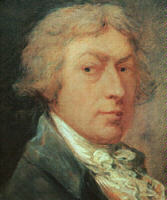|
|
Thomas Gainsborough
(1727-1788) |
Special thanks to the Microsoft Corporation for permission to use following biographical information from Microsoft® Encarta '97:
Thomas Gainsborough was an English painter who is considered one of the great masters of portraiture and landscape.
Life:
Gainsborough was born in Sudbury, Suffolk, on May 14, 1727. He showed artistic ability at an early age, and when he was 15 years old he studied drawing and etching in London with the French engraver Hubert Gravelot. Later he studied painting with Francis Hayman, a painter of historical events. Through Gravelot, who had been a pupil of the great French painter Antoine Watteau, Gainsborough came under Watteau's influence. Later he was also influenced by the painters of the Dutch school and by the Flemish painter Sir Anthony van Dyck. From 1745 to 1760 Gainsborough lived and worked in Ipswich. From 1760 to 1774 he lived in Bath, a fashionable health resort, where he painted numerous portraits and landscapes. In 1768 he was elected one of the original members of the Royal Academy of Arts; and in 1774 he painted, by royal invitation, portraits of King George III and the queen consort, Charlotte Sophia. Gainsborough settled in London the same year. He was the favorite painter of the British aristocracy, becoming wealthy through commissions for portraits. Gainsborough died in London on August 2, 1788.
Work:
Gainsborough executed more than 500 paintings, of which more than 200 are portraits. His portraits are characterized by the noble and refined grace of the figures, by poetic charm, and by cool and fresh colors, chiefly greens and blues, thinly applied. Among his world-famous portraits are Orpin, the Parish Clerk (Tate Gallery, London); The Baillie Family (1784) and Mrs. Siddons (1785), both in the National Gallery, London; Perdita Robinson (1781, Wallace Collection, London); The Hon. Francis Duncombe (1777?, Frick Collection, New York City); Mrs. Tenant (1786-1787, Metropolitan Museum, New York City); and many in private collections, including The Blue Boy (1779?, Huntington Collection, San Marino, California). His portrait Mr. and Mrs. Andrews (1750?, National Gallery, London) is unusually balanced between portrait and landscape painting.
The effect of poetic melancholy induced by faint lighting characterizes Gainsborough's paintings. He was obviously influenced by Dutch 17th-century landscape painting. Forest scenes, or rough and broken country, are the usual subjects of his landscapes, most notably Cornard Wood (1748) and The Watering Place (1777?), both in the National Gallery, London. Gainsborough also executed many memorable drawings and etchings.
 |
Online Since 1996 |
|


